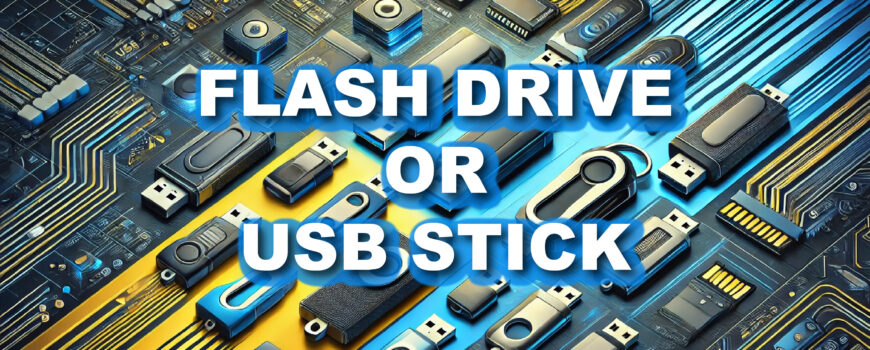In today’s digital world, storing and transferring data efficiently is essential. Many people use the terms “flash drive” and “USB stick” interchangeably, but is there actually a difference between the two? If you’re searching for reliable storage solutions, understanding that there are no distinctions can help you make an informed decision. In this article, we will confirm that there is no difference between a flash drive and a USB stick, as well as talk about their functions, and common misconceptions.
Flash Drive vs. USB Stick: Are They the Same?
A flash drive and a USB stick refer to the same type of device in most everyday conversations. So, short answer, they’re the same thing. Both terms describe a portable storage device that uses flash memory and connects to a computer or other devices via a USB (Universal Serial Bus) port. Flash drives and USB sticks are widely used for storing, transferring, and backing up files due to their convenience and reliability.
The term “flash drive” is derived from “flash memory,” the type of storage technology these devices use. Flash memory is non-volatile, meaning it retains data even when the power is turned off. “USB stick” is a more informal name that comes from the compact and stick-like design of these storage devices.
While some, like myself, might argue there is a technical distinction, in practical terms, a flash drive and a USB stick are essentially the same product. When you see these terms on the internet or even in conversation, they mean the same thing. Only if you are speaking with an IT professional is it possible that they might be reffering to something different.
Richard Garrish
How Does a Flash Drive Work?
A flash drive operates using NAND flash memory, a type of solid-state storage that doesn’t require moving parts. This makes flash drives durable and resistant to more physical damage compared to traditional hard drives. When plugged into a USB port, the device is recognized as external storage, allowing users to drag and drop files for quick and easy data transfer.
Flash drives are available in various capacities, ranging from a few gigabytes (GB) to several terabytes (TB), making them suitable for a wide range of applications, including personal file storage, professional use, and even bootable operating systems. At EBS, we even offer customization like custom labeling and preloading to our customers as a service. Customers use these drives for many purposes like advertising their company or preloading sharable documents to hand out.
Common Uses for Flash Drives and USB Sticks
Because of their portability and reliability, flash drives (or USB sticks) are used in numerous ways. Many people rely on them for data transfer, as they allow quick and easy movement of files between computers or printers. They are also commonly used for data storage, helping users create copies of important documents, photos, and videos. Flash drives can function as bootable drives, enabling users to install operating systems or troubleshoot computers. Additionally, they offer security and encryption options for storing confidential data with password protection. Many customers use them for media storage, allowing them to carry music, movies, and presentations on the go.
Are There Different Types of Flash Drives?
Yes, there are several variations of flash drives based on their functionality and connection type. USB flash drives come in different speed categories, including USB 2.0, USB 3.0, and USB 3.1/3.2, with newer versions offering faster read and write speeds. There’s even USB4 on the way. USB-C flash drives are designed to be compatible with modern laptops, smartphones, and tablets. Some models feature encryption, providing extra security with password protection and advanced encryption features. High-capacity flash drives are available for professionals and content creators who require larger storage capacities.
People Also Ask: Similar Questions About Flash Drives and USB Sticks
Many people searching for “flash drive vs. USB stick” also ask related questions, such as:
Is a USB flash drive the same as an external hard drive? No, an external hard drive typically uses a mechanical spinning disk (Usually reffered to as HDD) or solid-state drive (SSD) technology and offers much larger storage capacities compared to flash drives.
What is the difference between a USB drive and a thumb drive? A thumb drive is used as another name for a USB flash drive. The term “thumb drive” comes from the small, thumb-sized shape of the device. ThumbDrive is actually a trademarked term by Trek 2000, the original flash drive creators, but was widely popularized and the company has stopped pursuing litigation. Again, all these terms are talking about the same thing. Jump drive, pen drive, memory stick, usb drive, all referring to a flash drive with a USB port on it.
Do all flash drives work with any computer? Most flash drives are universally compatible with any device that has a USB port. However, newer USB-C flash drives may require an adapter for older computers with only USB-A ports. There may also be formatting issues between your flash drive and your computer that limit read/write abilities. You can read more about that here.
Final Thoughts: Choosing the Right USB Storage Device
Whether you call it a flash drive, USB stick, or thumb drive, these portable storage devices are a great tool to use in the office, at home, or at school. While the terms are interchangeable, understanding their functions and types ensures you select the best device for your needs.
If you’re looking to buy bulk flash drives, SD cards, or other memory solutions, our website offers high-quality products at competitive prices. Browse our selection today to find the perfect storage solution for your needs!

